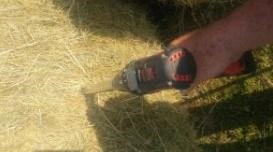By Kevin Laurent

With current feed prices, if there was ever a time to test your hay it is this year!
The ancient Greek philosopher Heraclitus once said, “The only constant in life is change” and boy have things been changing lately. Given all the negativity that seems to catch the headlines, there has been some positive changes in the cattle markets. The late summer price rise in heavy feeders is historically normal. What’s not so normal is heavy feeder prices have held their ground and, in some cases, strengthened as we have entered the fall runs. This contraseasonal move in the market is good news for beef producers, especially for folks backgrounding or preconditioning calves this fall and winter. This recent market move along with a generally favorable market outlook was a one of several areas that Dr. Kenny Burdine covered in his keynote presentation at the recent Stockmanship and Stewardship School in Bowling Green, KY. However, as good and informative as this presentation was, the one statement my good friend Kenny made that stuck with me the most was when he warned producers not to fall victim to “feed price sticker shock” when making management decisions. We all know that feed prices are higher this fall than they were this time last year. But what we need to remind ourselves is that the biology of our cows has not changed since last year, meaning that we still need to provide balanced nutrition for desired outcomes. So how do we overcome “Feed Price Sticker Shock” and avoid management paralysis?
Inventory your feed resources and test your hay/forage. With current feed prices, if there was ever a time to test your hay it is this year. Many county extension offices provide this service free of charge. Once you get those results back, plug the numbers into the UK Beef Cow Forage Supplement Tool forage-supplement-tool.ca.uky.edu to determine what supplement you will need. You may find that some of your poorer hay will still meet the needs of a dry cow in mid gestation. Those are the cows you just weaned. Consider closing some gates and feeding weaned dry cows hay now and saving stockpiled forage for closer to calving. Most years stockpiled fescue will test 10-12 % protein and 60-62% TDN well into February or even March. Those numbers will maintain a lactating cow with little to no supplement.
Maintain body condition and supplement cows if needed. Make sure cows are in body condition score 5-6 by calving time. This means no visible backbone, hooks/hip bones or middle ribs. Supplementing hay this fall and winter and having cows in proper condition at calving will result in stronger calves at birth and higher quality colostrum. After calving, continue to meet nutritional needs. For spring calving herds, the February/March period can be the most challenging time to maintain body condition. Use any available stockpiled fescue and/or supplement hay diets with the proper concentrates.
Don’t try and make it on hay alone. Obviously if your hay is good enough to maintain body condition you can just feed hay. But we know most of the time our hay is not sufficient to get this done. Let’s use a 30 cow herd and a decent hay that tested 9% protein and 54% TDN on a dry matter basis for an example. We know that lactating cows need a diet that is roughly 11% protein and 60% TDN to maintain condition. We plug the hay numbers into the UK Beef Cow Forage Supplement Tool and it recommends either 4 lbs of dried distillers or 5-6 lbs of 50:50 soyhull:gluten. So, what will that cost? Let’s say feed is $300 per ton. If we feed 5 lbs for 60 days (February/March) that will cost $45/cow or $1350 total. Remember how you manage prior to and after calving also affects breed back rate and the 2023 calf crop which could be the highest value calves we have sold in recent years. Proper feeding may be the difference between a 70% 2023 calf crop and a 90% 2023 calf crop. In a 30 cow herd, that could be a difference of 6 additional higher value calves to sell in the fall of 2023. The $1350 you spend on supplement this winter could reap huge dividends in 2023.
Don’t abandon preconditioning and backgrounding programs. Currently price spreads between unweaned bawling calves and weaned value added calves has narrowed dramatically. Average prices for the week of 10/17/21-10/23/21 for medium and large 1-2 525-575 lb steers were $154.11 – $146.35, whereas 675 to 825 value added steers ranged from $153.13 – $151.58. With this value of gain, preconditioning and backgrounding budgets still look favorable even in the face of higher feed costs. Remember, calves need to gain to make these programs work. Feeding at 2% body weight of a 14-16% protein concentrate feed is still the best practice for the 60-90 day preconditioning programs. Recent closeouts from PVAP participants with the highest returns over expenses were the ones who put 150 lbs or more of weight gains on calves prior to sale.
Finally, try and stay positive. There is lots of negativity out there so try and filter the negative and concentrate on the good. Its times like these that challenge us to do a little better and rethink some of our habits and practices. Market dynamics are good so let’s negotiate our way through these high input times so we can be there to reap the benefits of better prices and times.
Source : osu.edu